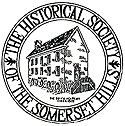Bernardsville Awarded First Historic District
Olcott Avenue Historic District
added to New Jersey Register of Historic Places
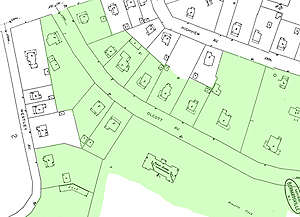
The New Jersey State Review Board for Historic Sites recommended the creation of the Olcott Avenue historic district on February 10, 2009 said Darlene Yuhas, spokeswoman for the state Department of Environmental Protection.
The board’s recommendation was reviewed and signed by acting DEP commissioner Mark Mauriello and took effect on May 20, 2009 -(SR#4896). (Click Map to view area)
Bernardsville’s first historic district designation also now moves on to the U.S. Department of the Interior for consideration to include the area on the national historic registry. The Olcott Avenue historic district includes Olcott Avenue and portions of Childsworth and Highview avenues, Church Street, and a small portion of Mullens Lane.
The designation follows a long detailed process that was coordinated by Dan Lincoln, an Olcott Avenue resident and long time historic advocate, along with the Bernardsville Historic Preservation Advisory Committee, the Historical Society of the Somerset Hills and other Bernardsville neighborhood and community organizations. Dan Lincoln is also the current President of The Historical Society of the Somerset Hills.
Olcott Avenue District History
Olcott Avenue is named after Frederick Pepoon Olcott (1841-1909), a Bernardsville mountain colony resident who was president of the Central Trust Company in New York which later was merged with JP Morgan. Olcott owned a Bernardsville estate which included the area including the Somerset Hills Country Club.
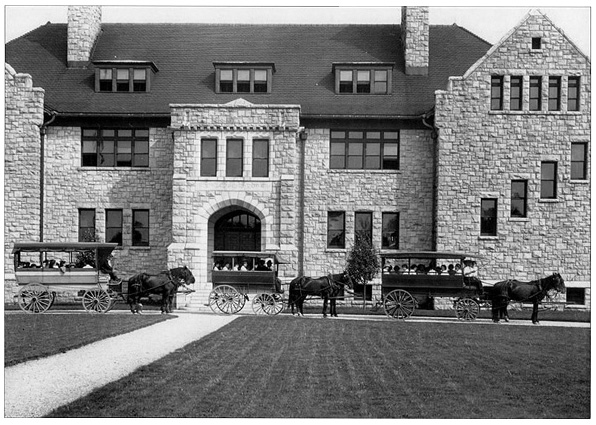
In 1905 a local resident, Frederick P. Olcott bought twenty-seven acres of what was then known as the Wolfe tract of what is now Olcott Avenue for $10,000. He erected the present stone 9 room Olcott Building at a cost of approximately $100,000 and presented the property to the Bernards Township school district (Berndardsville was still part of Bernards Twp until 1924).
This building served as the first high school in Bernards Township and also housed Bernardsville’s elementary grades. That building was designed by architect Henry Janeway Hardenbergh. Hardenbergh also was the architect for the Plaza Hotel, the Waldorf Hotel and the Dakota Apartments in New York City, Lincoln said.
While the Olcott Avenue School is but one historic structure within Bernardsville’s first historic district area, the areas appeal and historic significance remembers the story of the rise of the middle class in Bernardsville and how this particular location impacted the entire region, from the downtown, Little Italy, and even the Mountain Colony areas.
Olcott Avenue Historic District
The outlined historic district encompasses about 46 public and private properties on Olcott Avenue and some surrounding streets, Lincoln said, adding that he and other local historians have been working on the historic designation project for about three years.
The Olcott Avenue historic district includes Olcott Avenue and portions of Childsworth and Highview avenues, Church Street, and a small portion of Mullins Lane just north of the downtown area of Bernardsville, New Jersey.
74 structures in the district
Period of significance – 1899 – c. 1930
Historic Grants Available with District Recognition
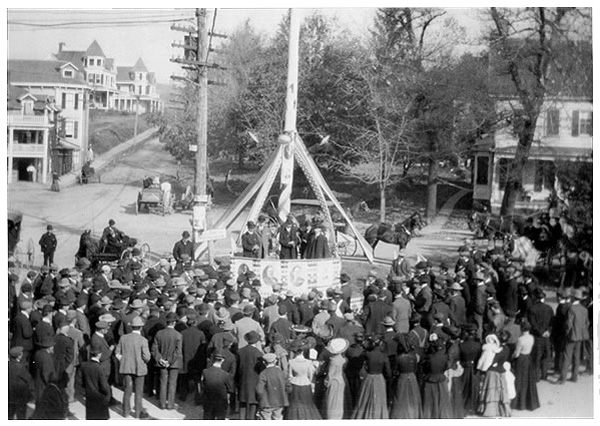
“The historic designation would not restrict what changes homeowners can make on their private property,” Lincoln and Yuhas said. Actually, structures within the district are eligible to apply for certain grants to make improvements to their structures. One project of interest is the century-old clay roof on the Olcott Building.
Click Here to learn more about the benefits of State and National historic districts.
The Somerset Hills Board of Education, which oversees the local school system Olcott Ave building and the Bernards High School at 25 Olcott Avenue, noted the New Jersey Historic Trust is offering historic site management grants though its Garden State Historic Preservation Trust Fund and is planning to apply for a $14,500 grant for repairs needed at the Olcott building. The resolution was approved at it’s May 20, 2009 meeting.
Historic Olcott District Homes
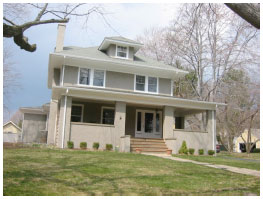
In 2006, The Historical Society of the Somerset Hills awarded 26 Olcott Avenue a prestegious Historic Preservation award. The Arts and Crafts inspired house at this private residence at 26 Olcott Avenue in Bernardsville might be less ornate in style than some of the other houses on the street, but its owners recognized the strength in its simplicity, a hallmark of Arts and Crafts style. Not only did they undertake a careful project to preserve and maintain the exterior, they also added an addition, discreetly located at the rear, which is compatible to the architectural style and unobtrusive to the historic streetscape.
Historic Bernardsville
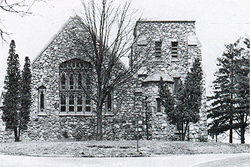
While the Olcott Avenue area is the first historic district in Bernardsville, there are a number of structures that are on New Jersey Historic Registry from Bernardsville including:
- St. Bernard’s Episcopal Church (ID#4269)
- St. Bernard’s Church and Parish House (ID#4639)
- Bernardsville Railroad Station (ID#2477)
- Bernardsville Municipal Building (ID#2901)
- Gill-Saint Bernards Lower School (ID#2478)
- Morristown National Historical Park (ID#3381)
- John Parker Tavern (ID#2479)
- Reynolds-Scherman House (ID#2480)
Notable Historic Abstracts
Below are exerpts taken from the application to the New Jersey Historic Preservation Office:
The Rising Middle Class
Significance in the area of community development stems from Olcott Avenue as the first street in Bernardsville designed to specifically appeal to the local rising class of merchants and entrepreneurs. It did so by means of deed restrictions regarding lot size, building setbacks, property use, and fence limitations that were harbingers of future local zoning ordinances.
During the opening decades of the 20th century, Olcott Avenue was the most fashionable street in Bernards Township (Bernardsville and Bernards Twp today), outside the Mountain Colony.
Olcott Avenue was significant during the period of its development as a neighborhood intended to appeal to an increasingly prosperous class of local merchants and business owners by means of deed restrictions placed on each property, which were to be the forerunners of local zoning ordinances enacted several decades later. While not unique in America at the time, the deed restrictions were a novel introduction in a traditionally rural area.
For more than 150 years, Bernards Township had been an agrarian community composed of dispersed farmsteads with several small crossroads hamlets to provide needed services. Bernardsville, which was originally known as Vealtown, was one of those hamlets.[3] The late 19th-century development of the Mountain Colony brought a group of Gilded Age tycoons who needed local services and goods for their baronial estates. They needed carpenters, masons, farm workers, and servants, and Bernardsville saw an influx of workers, including Italian, German, Irish, and East European immigrants, who moved into new neighborhoods of simple working class houses, such as a section south of the railroad depot that was established before the turn of the 20th century and was later known as Little Italy.
However, during the 1920s, the Ku Klux Klan appeared in Basking Ridge, led by Rev. Carl Mellberg of the Basking Ridge Methodist Church. With its focus during that period on white supremacy, anti-Catholicism, anti-Semitism, and opposition to foreign immigration, it had a sizable following for several years. This was a dramatic change for Bernardsville and for the township as a whole that would stir up anxieties among the older residents for a number of decades. At the same time, a middle class of local professionals and merchants was emerging in Bernardsville, as a byproduct of the development of Bernardsville’s enclave of baronial summer estates, which resulted in an increasing population of workers who benefited from wages paid by the tycoons of the Mountain Colony. The workers, in turn, spent their wages in Bernardsville’s shops and businesses, thereby increasing the prosperity of the local merchants and professionals.
Thus, by the late nineteenth century, there was a developing market for homes that would appeal to this newly prosperous middle class.
Frederick P. Olcott and The Olcott Avenue School
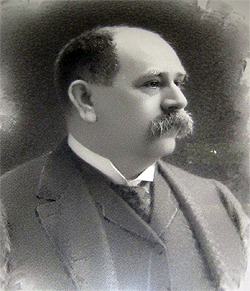
The land and building donated to Bernards Township Board of Education by financier and philanthropist Frederick P. Olcott (1841-1909), who was president of the Central Trust Company in New York and also owned a large estate in Bernardsville. Frederick Olcott was the youngest of eleven children of Thomas Worth Olcott, president of the Mechanics and Farmers Bank of Albany, NY. While Frederick died in his home in Bernardsville, he is buried with his family in Albany NY.
Frederic Pepoon Olcott (1841-1909), the son of well-to-do Albany banker, moved to New York City after the Civil War, where he worked as stockbroker for ten years. In 1882, he joined the ten-year old Central Trust Company of New York, and was named president in 1884. In 1888, Olcott purchased a 125-acre farm from George I. Seney, eventually increasing his property to nearly 500 acres, which he called Round Top Farm. The Olcotts were summer residents of the Mountain Colony, retaining a handsome house on East Fifty-third Street in New York City.
From the schoolboard notes is a mention of Olcott’s donation. This surprising and brief entry remained the only mention within the minutes of Olcott or his extraordinary offer until the March 1905 annual school meeting, when Olcott was nominated from the floor and elected to the board; Olcott, however, was unable to accept the election due to ill health.With a new Bernardsville schoolhouse having been taken care of by a benefactor, the board was free to move forward to build a new schoolhouse at Liberty Corner.
At the January 29, 1904 school board meeting, a motion was passed to construct a new schoolhouse at Bernardsville. The proposal was subsequently discussed at two public meeting over the next several weeks, with no apparent resolution until what seems to have been a surprise announcement at the March 26th board meeting. It was then, according to board minutes, district clerk J. E. Ballentine “reported that Mr. F. P. Ollcot [sic] was a going to secure land and erect a School House at Bernardsville for the Township of Bernards.”
The community also honored Frederic Olcott by promptly renaming Wolfe Avenue and the downtown business area (Olcott Square) after him.
Architects
The Olcott Avenue School, designed by noted New York architect Henry Janeway Hardenbergh (1847-1918), owned a large estate in Bernardsville. Considered by architectural historians to be one of the great architects of his time, Henry Janeway Hardenbergh (1847-1918) is most well known for his New York commissions, particularly the 1884 Dakota apartment building, the 1893 Waldorf and 1897 Astoria hotels, and, most famously, the 1907 Plaza hotel. The hotels he designed were considered at the time they were built to be the finest in the world and gave him a worldwide reputation. His design for the Copley-Plaza in Boston has been called his best work. Born in New Brunswick, New Jersey, and a descendent of Reverend Jacob Rutsen Hardenbergh who was the founder of that city’s Queens (later Rutgers) College, Hardenbergh designed and superintended the construction of a library and chapel for the college in 1871.
Hardenbergh’s design for the Olcott School may have served as the genesis for the much larger Natirar mansion. Both buildings feature large hip roofed central blocks with tower-like Tudor-arch central entries, flanked on each end by projecting bays.
Four outstanding buildings designed by prominent American architects of the period make up the Olcott Avenue Historic District area:
- William Stone Post (son of George B. Post), who designed the 1903 Tudor Revival Methodist Episcopal Parsonage;
- Henry Janeway Hardenbergh, who designed the 1905 Tudor Revival Olcott School;
- Dennison & Hirons, who designed the 1914 Methodist Episcopal Church, also Tudor Revival;
- William Davenport Jones, who designed the 1905 Shingle style house at 36 Olcott Avenue.
School System Develoment
In Bernards Township, three new multi-room schools were constructed between 1903 and 1905, a remarkable accomplishment for a rural community that resulted in the closure of five outdated schoolhouses. New four-room schools were built in Basking Ridge (1903 – Maple Ave) and Liberty Corner (1904). In Bernardsville, the new school building built in 1905 and donated to the Bernards Township Board of Education by Frederic P. Olcott provided space for the first public high school in the township.
In Bernards Township, a small group of progressives organized in 1903 the Basking Ridge Improvement Society, with the modernization of the local school system as one of their major concerns.
In 1906, the Board of Education supported the election of Olcott Avenue resident Dr. Clare Henry to the Board. In his 1904 School Report, Somerset County Superintendent H.C. Krebs singled out Bernards Township for taking the lead – through its ambitious school construction program – in a movement toward “an awakening and an enterprise that augur well for the educational future of the county.” In 1905, the number of grammar school graduates was only sixty-five in all of Somerset County; no high school graduates were reported in the county that year or the following year.
Michael McGerr, A Fierce Discontent: The Rise and Fall of the Progressive Movement in America, 1870-1920, New York: Simon & Schuster Inc., 2003. From 1900 to 1909, in America the enrollment rate for children aged 5 to 19 in all types of schools rose from 50.5 per 100 to 59.2; public secondary-school enrollments grew from 519,000 to 841,000; expenditures per pupil in public schools increased from $14 to $24; and the average public school term lengthened from 144.3 days in 1900 to 155.3 days in 1909.
The handsome new Bernardsville schoolhouse, designed by renowned New York architect, Henry Janeway Hardenbergh, was comprised of two floors with four classrooms each and a third floor with a large hall and four small classrooms. It was erected at what was for the time and rural locale an extraordinary cost of over $100,000 on land purchased for $10,600. The deed conveyed by Olcott to the Board of Education contained restrictions to assure that the property would be used in perpetuity for non-sectarian educational purposes, that the school would be free to all township school children, and that the property should not be sold, mortgaged, or pledged for any reason. This “splendid gift,” as it was still called years later, suddenly transformed the education opportunities in the township.
Wolfe Avenue (Aka Olcott Avenue)
Wolfe Avenue was swiftly renamed Olcott Avenue in recognition of Olcott’s gift, and the central square in Bernardsville was dedicated to him. An inscription beneath a portrait of Olcott that still hangs in the old school building reads: “Patron and Benefactor of Education.” Wolfe Avenue (the original name for Olcott Avenue) was laid out as a public road in 1899, per a deed between heirs of Stewart Wolfe and Frank B. Allen, who would control all the land fronting on the broad new road, which was originally dirt. In 1869, Stewart Wolfe, who lived in New York City at the time, had purchased fifty-seven acres for $5,700 from Walter K. Sturges, who had owned the property for only three years when he sold it.
In January 1903, a U-shaped tract south of Wolfe Avenue was proposed for subdivision into ninety-five building lots of 50×200 feet and smaller. Some Bernardsville residents may have looked upon the proposal with alarm at the potential for many additional school children. Prosperous Wolfe Avenue residents may also have felt conflicted at the prospect that the proposed subdivision might intrude upon the special nature of their neighborhood, with its restricted deeds, spacious lots, and substantial houses. While many of the residents of Wolfe Avenue had deep roots in the township, in all likelihood the proposed subdivision would attract many less affluent outsiders. On the other hand, the merchants and professionals who made up the majority of Wolfe Avenue residents could also view any new residents as potential new customers and clients.
At the time the new school building was completed in 1905, there were more than half a dozen substantial homes constructed on Olcott Avenue, which, with its substantial, architecturally distinctive houses lining a broad tree-lined street, was unique in Bernards Township.[12] Early Olcott Avenue residents included William R. Bromfield, who established the first hardware, plumbing and tinning business in Basking Ridge; Benjamin Amster, a butcher and grocer; Charles Alpaugh, a local real estate broker; Dr. Clare Henry, the first dentist in the village; and Ulrich Eberhardt, Dr. Henry’s brother-in-law, who as a commuter was atypical of the majority of residents in the neighborhood.
For the school project, Olcott moved quickly to acquire twenty-six acres from the heirs of Stewart Wolfe, paying $10,600 in April 1904 For the U-shaped tract on the south side of Wolfe Avenue that had been proposed for subdivision into ninety-five building lots the previous year.[13] He engaged another resident of the Mountain Colony, the architect Henry Janeway Hardenbergh, to design the new high school.
Hardenbergh’s schoolhouse design was quite grand for the village, and certainly more sophisticated in detail than any other school in the township. Remarkably, despite having to import many of the materials, the school was designed and construction was completed within twelve months.
Somerset County Superintendent Krebs singled out the new school for praise in his 1905 School Report:
The magnificent stone school building donated to Bernards township by Mr. Frederick Olcott. . . has been completed. . . . Its cost will approximate $80,000. When it is considered that it provides for but eight school rooms, it can be seen that no expense has been spared to make the building a model of beauty and convenience. The spacious grounds, the gymnasium, the fine offices and numerous toilet rooms are a few of the features that unite to make this new building an example of what a modern school should be. The effect of this gift on the welfare of the children cannot be estimated.

Remarkably, the institutional buildings in the neighborhood have all survived largely intact, too. A number of improvements to the school property were undertaken during the 1960s, including a large expansion of the 1928 high school and the demolition of the 1912 “B” building. A news article from 1963 promoted a proposed bond referendum to fund improvements to the Olcott building, including removing the wooden stairs, flooring and wainscoting, which were not carried out.
Photo: The Visiting Nurse Association after incorporating in 1906, moves into a home constructed by the friends of the Association on Olcott Avenue in Bernardsville.
In 1985, all classes were moved out of the Olcott Building, which was then converted into administrative offices while preserving the exterior and much of the original interior architecture. Similarly, the interiors of the Methodist Church and Parsonage have been remodeled over the years, yet the exteriors of the buildings are relatively unchanged with the exception of ill-advised panels placed on the exterior of the church’s largest stained glass windows. The Visiting Nurse Association sold their headquarters in 2006 and moved to a larger facility they constructed in Bernards Township. Their Olcott Avenue building was subsequently converted to residential use.
“H.J. Hardenbergh, Architect, Is Dead,” New York Times, March 14, 1918.
Ibid.
The other Bernards Township hamlets were Basking Ridge, Liberty Corner, Madisonville, Franklin Corners, and Lyons.
During the 1920s, the Ku Klux Klan appeared in Basking Ridge, led by Rev. Carl Mellberg of the Basking Ridge Methodist Church. With its focus during that period on white supremacy, anti-Catholicism, anti-Semitism, and opposition to foreign immigration, it had a sizable following for several years. (Edward A. Schroeder and Wayne F. Koppes, Basking Ridge Methodism, Vol. I, Bernardsville, NJ: Hill Press, [1983].
Dr. Henry’s election bid failed that year, but he ran successfully in 1908. Sutro, p. 6.
Annual Report of the State Board of Education, 1904, p. 64.
“Map showing a portion of the estate of Stewart Wolfe Dec’d at Bernardsville,” filed January 30, 1903.
BOE minutes, March 25, 1904.
BOE minutes, March 21 and 25, 1905.
Olcott retired from that position in 1905 and was then named chairman of the board. Central Trust Company eventually became Manufacturers Hanover Trust Company.
According to township tax records, by 1892 Olcott, Seney and Post were the three largest taxpayers. Bernards Township Tax Records, 1892.
Property owners were Ulrich Eberhardt, Ermonce V. Henry, William R. Bromfield, Charles W. Alpaugh, Irving Davis, Cora L. Prout, Charles F. Mast, and David H. Morris, who purchased several lots to develop. SC Deeds, Book F10, p. 35.
“Map showing a portion of the estate of “Stewart Wolfe Dec’d at Bernardsville.”
Annual Report of the State Board of Education and the Superintendent of Public Instruction of New Jersey for the School Year ending June 30th, 1905, Paterson, NJ: News Printing Co., 1906, p. 89.
“Olcott School Was Given To Borough,” Bernardsville News, undated clipping c. 1963 at the BPL Local History Room.



